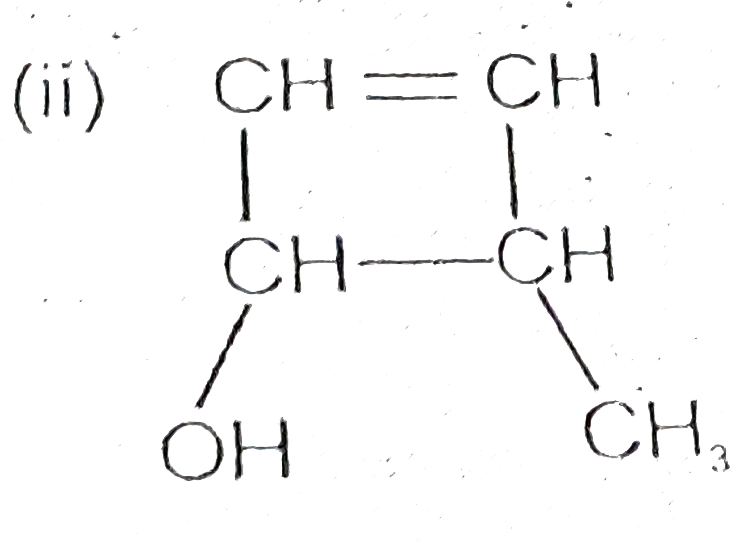The structrue of the enol form of
CH3−CO−CH2−CO−CH3 with intermolecular hydrogen bonding is…..
To determine the structure of the enol form of the compound CH3−CO−CH2−CO−CH3 with intermolecular hydrogen bonding, we will follow these steps:
Step 1: Identify the Keto Form
The given compound is \( CH_3-CO-CH_2-CO-CH_3 \). This is the keto form because it contains the ketone functional group (C=O).
Step 2: Write the Structure of the Keto Form
The structure can be drawn as follows:
CH3|C=O|CH2|C=O|CH3
Step 3: Understand Tautomerization
To convert the keto form to the enol form, we need to understand tautomerization, which involves the migration of a hydrogen atom and the shifting of a double bond. In this case, a hydrogen atom from the alpha carbon (the carbon adjacent to the carbonyl group) will shift.
Step 4: Identify the Alpha Hydrogens
The alpha carbons in the structure are:
- Carbon 1 (C=O)
- Carbon 2 (CH2)
- Carbon 3 (C=O)
Step 5: Perform the 1,3-Hydrogen Shift
The hydrogen from Carbon 2 (the alpha carbon) will shift to the oxygen of the carbonyl group (C=O) on Carbon 1. This results in the formation of a double bond between Carbon 2 and Carbon 3.
Step 6: Write the Enol Form Structure
After the hydrogen shift, the structure of the enol form will be:
CH3|C=CH|C=O∣CH3
In this structure, we also have an -OH group formed due to the hydrogen bonding.
Step 7: Indicate Intermolecular Hydrogen Bonding
In the enol form, the -OH group can form hydrogen bonds with the carbonyl oxygen of another enol molecule. This interaction is known as intermolecular hydrogen bonding.
Final Structure
The final structure of the enol form with intermolecular hydrogen bonding can be represented as:
CH3|C=CH−O−H|C=O∣CH3
The given compound is \( CH_3-CO-CH_2-CO-CH_3 \). This is the keto form because it contains the ketone functional group (C=O).
The structure can be drawn as follows:
CH3|C=O|CH2|C=O|CH3
To convert the keto form to the enol form, we need to understand tautomerization, which involves the migration of a hydrogen atom and the shifting of a double bond. In this case, a hydrogen atom from the alpha carbon (the carbon adjacent to the carbonyl group) will shift.
The alpha carbons in the structure are:
- Carbon 1 (C=O)
- Carbon 2 (CH2)
- Carbon 3 (C=O)
The hydrogen from Carbon 2 (the alpha carbon) will shift to the oxygen of the carbonyl group (C=O) on Carbon 1. This results in the formation of a double bond between Carbon 2 and Carbon 3.
After the hydrogen shift, the structure of the enol form will be:
CH3|C=CH|C=O∣CH3
In this structure, we also have an -OH group formed due to the hydrogen bonding.
In the enol form, the -OH group can form hydrogen bonds with the carbonyl oxygen of another enol molecule. This interaction is known as intermolecular hydrogen bonding.
The final structure of the enol form with intermolecular hydrogen bonding can be represented as:
CH3|C=CH−O−H|C=O∣CH3
Topper's Solved these Questions
- BOOK - CENGAGE CHEMISTRY ENGLISHCHAPTER - ISOMERISMEXERCISE - True False (Exercise)2videos
ISOMERISM
- BOOK - CENGAGE CHEMISTRY ENGLISHCHAPTER - ISOMERISMEXERCISE - Analytical and Descriptive Type (Exercise)6videos
ISOMERISM
- BOOK - CENGAGE CHEMISTRY ENGLISHCHAPTER - ISOMERISMEXERCISE - Assertion-Reasoning Type (Exercise)5videos
ISOMERISM
- BOOK - CENGAGE CHEMISTRY ENGLISHCHAPTER - IONIC EQUILIBRIUMEXERCISE - Archives Subjective28videos
IONIC EQUILIBRIUM
- BOOK - CENGAGE CHEMISTRY ENGLISHCHAPTER - NCERT BASED EXERCISEEXERCISE - Chemical Equilibrium73videos
NCERT BASED EXERCISE
Similar Questions
The IUPAC name of (CH3CH2CO)2O is
View SolutionGive the IUPAC name of the compound
CH3−CH2−CH2−CO−CH3View SolutionGive the IUPAC name of the compound
CH3−CO−CH2−CH2−CH3View SolutionWrite its bond line formula
(i) CH3CH(OH)CH2CH2OH View Solution
View SolutionCH3−CHO&C6H5−CO−CH3 can reacts similarly with
View SolutionGive the IUPAC name of the compound
CH3−CO−CH2−CH3View SolutionGive the IUPAC name of the compound
CH3−CH2−CO−CH3View SolutionGive IUPAC name for each of the following
CH3−CO−CO−CH2CH3View SolutionGive the IUPAC name of the compound
CH3−CH(OH)−CO−CH2−CH3View SolutionThe IUPAC name of BrCH2−CH(CONH2)−CO−CH2−CH2−CH3 is
View Solution

